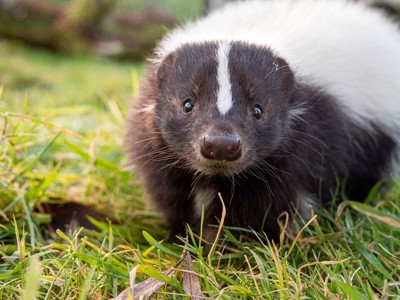
Skunk
Scientific name: Mephtitis Mephitis
There are many different varieties of skunk, of which almost all live in North America. At Noah’s Ark Zoo Farm, we have a striped skunk (Mephitis mephitis).
The skunk is, perhaps, most renowned for its ability to produce a foul-smelling spray which it uses as a predator-deterrent. This spray is an oily liquid that is produced in the glands under the skunk’s tail. When under threat, the skunk turns around and blasts its adversary with the potent spray. The scientific name for skunk (mephitis) actually derives from the Latin word Mephit, meaning bad odour!
Striped skunks are found in a range of habitats in North America including wooded areas, scrublands, forests and grassy plains. They can also be found in suburban and urban areas; because of this, people often see as skunks as pests.
Skunks usually breed once a year between the months of February and April. The skunk’s gestation period lasts between 59-77 days and a female skunk can have up to 10 young in a litter.

-
At Noah's Ark...
We have 2 Skunks... Rocket and Groot.
-
We live...
Next to the Prairie Dog enclosure, in front of the Red Deer enclosure.
-
Diet
Skunks are omnivores. They eat insects, small mammals, reptiles and amphibians. They also eat berries, leaves, roots, grasses and nuts.
-
Size Fact
They can grow up to 90cm (from nose to tail).
-
Food Fact
Skunks are nocturnal foragers.
You might also like...
-
![Meerkats]()
Meerkat Keeper Talk
Come along and learn about our mob of Meerkats from our experienced animal keepers.
Find out more
-
![Zoe And Falcon]()
Bird of Prey Flying Display
Watch our majestic birds of prey in our new Wings of Wonder flying display.
Find out more
-
![Andean Bear]()
Bear Keeper Talk
Learn about our Spectacled bears from our experts and find out what it is like to be a Spectacled bear keeper.
Find out more
-
![African Elephant - Shaka 2]()
Elephant Keeper Talk
Did you know Elephants are the largest land animals on Earth? Come and join our Elephant Keepers and learn about our bulls.
Find out more






